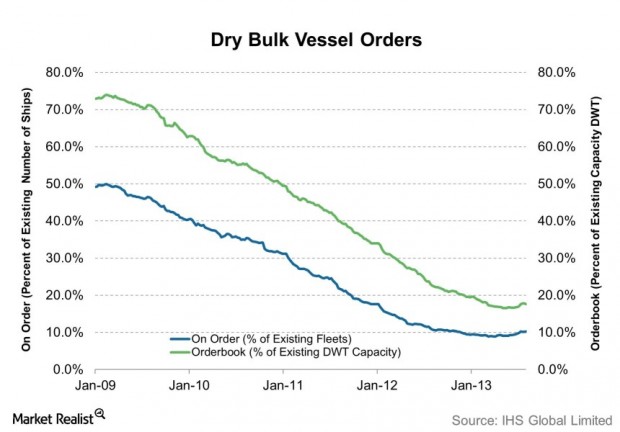One measure that reflects managers’ expectation of future supply and demand differences is the number of ships on order. When managers expect future supply to increase more than demand, they refrain from purchasing new ships. However, when they expect demand to outpace supply growth, companies return to the shipyard to place new orders, on the condition that they expect to generate profits with the new vessels. So rising ship orders often indicate that shipping rates will rise. Since dry bulk ships usually take one to two years to construct, the indicator is often more relevant to long-term investment horizons.
Ships on order remain in positive trend
On August 2, the number of dry bulk ships on order as a percentage of the existing number of ships rose from 10.18% a week ago to 10.24%. The dry bulk orderbook as a percentage of existing capacity (measured in deadweight tonnage, DWT—the weight ships can safely carry on the water) fell to 17.64% from 17.83% a week ago. Since “orderbook” includes the amount of ships under construction, the divergence between the two indicators reflects lower construction activity, while managers continued add the number of ships that will be constructed in the future.
Until early this year, new orders had remained depressed due to a record backlog of new ship deliveries. As supply was growing faster than demand, managers refrained from placing new ship orders. The rebound we’ve seen in new orders is a sign that managers see that much of the large backlog has cleared and that they expect demand to outpace supply growth. Diana Shipping Inc. (DSX), for example, has been purchasing several ships in the secondary market in anticipation of higher shipping rates and Knightsbridge Tankers Ltd. (VLCCF) has switched from operating in the tanker (oil shipping) industry to dry bulk.
Implication for dry bulk shipping outlook
A higher-expected-growth rate in demand relative to supply is positive for shipping rates, and it would translate into higher margins and earnings for dry bulk shipping companies such as DryShips Inc. (DRYS), Diana Shipping Inc. (DSX), Knightsbridge Tankers Ltd. (VLCCF), Safe Bulkers Inc. (SB), and Navios Maritime Partners LP (NMM).
While short- to medium-term fundamentals may still differ for each company, because dry bulk vessels can take up to two years to construct and firms such as Safe Bulkers Inc. (SB) and Navios Maritime Partners LP (NMM) are subject to lower revenue when some of their valuable contracts mature, the pace at which managers have been placing new orders (unlike tankers) suggests companies are rather optimistic regarding the dry bulk shipping industry’s outlook—likely due to large supply and demand growth differences in the near future. Moreover, since the value of a company is based on future expected earnings potential, the market has started to price in the favorable long-term outlook.
Dry Bulk Shipping Blast: Ship Orders
2013-08-07
2371人
Source:MarketRealist
Most ViewsHOT
- Jinjiang Shipping eyes up to eight boxship newbuilds
- Seacon snaps up six ultramax resales
- Winning Shipping in lead
- d’ Amico signs up MR1 newbuild deal in China
- Eastern Pacific adds capes to swelling Hengli orderbook
- Pacific Basin signs up for Chinese handysize newbuilds
- Essberger’s newbuild push rolls on with up to six chemical tankers in China
- Cape Shipping eyes VLCC entry as tanker expansion continues
- Wan Hai heads to Chinese yard for LNG-powered newbuilds
- Venergy steps into boxships with feeder newbuild deal in China

